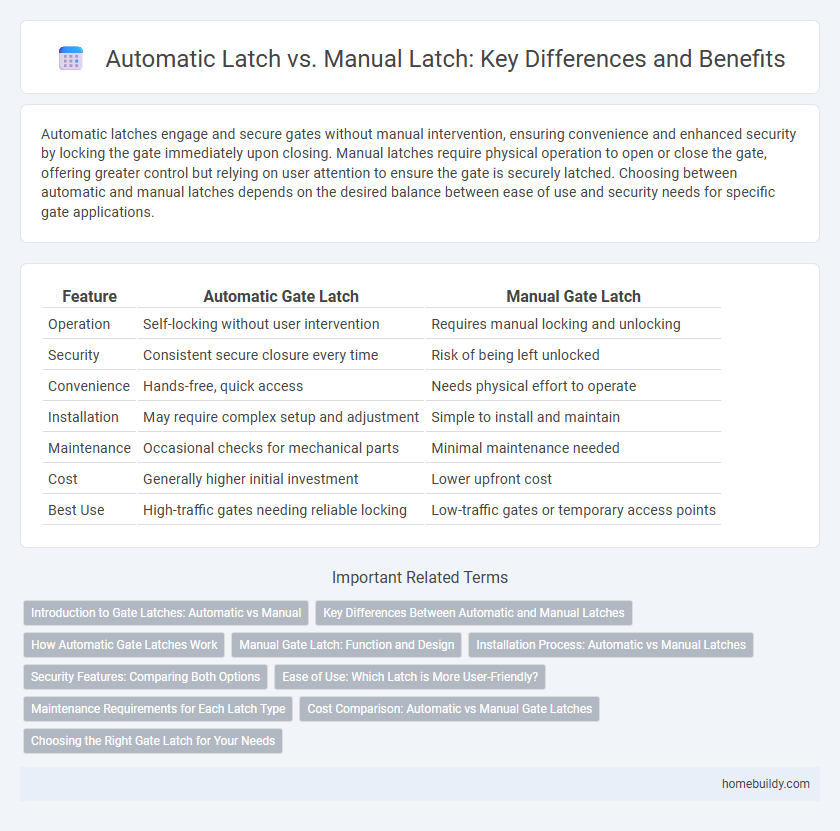Automatic latches engage and secure gates without manual intervention, ensuring convenience and enhanced security by locking the gate immediately upon closing. Manual latches require physical operation to open or close the gate, offering greater control but relying on user attention to ensure the gate is securely latched. Choosing between automatic and manual latches depends on the desired balance between ease of use and security needs for specific gate applications.
Table of Comparison
| Feature | Automatic Gate Latch | Manual Gate Latch |
|---|---|---|
| Operation | Self-locking without user intervention | Requires manual locking and unlocking |
| Security | Consistent secure closure every time | Risk of being left unlocked |
| Convenience | Hands-free, quick access | Needs physical effort to operate |
| Installation | May require complex setup and adjustment | Simple to install and maintain |
| Maintenance | Occasional checks for mechanical parts | Minimal maintenance needed |
| Cost | Generally higher initial investment | Lower upfront cost |
| Best Use | High-traffic gates needing reliable locking | Low-traffic gates or temporary access points |
Introduction to Gate Latches: Automatic vs Manual
Automatic gate latches engage without human intervention, providing enhanced security and convenience by locking the gate as it closes. Manual gate latches require physical effort to open and close, offering simplicity and control but potentially less ease of use. Choosing between automatic and manual gate latches depends on factors like desired security level, frequency of use, and installation complexity.
Key Differences Between Automatic and Manual Latches
Automatic gate latches engage and secure the gate without user intervention, providing convenience and enhanced security through features like self-locking mechanisms and quick-release options. Manual latches require physical operation to lock or unlock, offering simplicity and reliability but demanding user effort for each use. Key differences include the level of automation, ease of use, and security features, with automatic latches favored for frequent access points and manual latches suited for occasional or low-traffic gates.
How Automatic Gate Latches Work
Automatic gate latches operate using a spring-loaded mechanism that securely closes the gate without manual intervention, engaging the latch as the gate shuts. This design ensures consistent locking and improves security by preventing the gate from being accidentally left open. Many automatic latches also feature quick-release options for easy opening when needed, combining convenience with enhanced safety.
Manual Gate Latch: Function and Design
Manual gate latches rely on human operation to secure gates, offering reliable control and simplicity in design. They typically feature components such as a latch bar, handle, and catch plate, ensuring straightforward engagement and disengagement. These latches are favored for their durability, ease of installation, and minimal maintenance requirements in residential and agricultural gate applications.
Installation Process: Automatic vs Manual Latches
Automatic gate latches require a more complex installation process involving precise alignment of the latch mechanism and often need power sources or sensors for activation, which can increase setup time and technical skill requirements. Manual gate latches boast a simpler installation, typically involving straightforward mounting with basic tools and minimal adjustments, making them accessible for most users to install independently. The choice between automatic and manual latches hinges on balancing installation complexity with desired functionality and security needs.
Security Features: Comparing Both Options
Automatic gate latches offer enhanced security features such as self-locking mechanisms that engage immediately upon closing, reducing the risk of unauthorized access. Manual latches rely on user intervention for securing the gate, which can lead to vulnerabilities if users forget to lock them properly. Advanced automatic latches may include tamper-resistant designs and compatibility with electronic access controls, providing superior protection compared to traditional manual options.
Ease of Use: Which Latch is More User-Friendly?
Automatic gate latches offer superior ease of use by engaging and locking without requiring manual effort, ideal for frequent access and hands-free operation. Manual latches demand physical manipulation to open and close, which can be less convenient, especially for users with limited mobility or when carrying items. User-friendly automatic latches combine convenience with security, reducing the risk of gate remaining unsecured due to user error.
Maintenance Requirements for Each Latch Type
Automatic gate latches require periodic inspection and lubrication of internal components to ensure smooth operation and prevent rust or wear, making maintenance more frequent but less physically demanding. Manual latches demand routine cleaning and tightening of screws or bolts, with occasional replacement of broken parts, involving more hands-on effort compared to automatic latches. Both types benefit from weather-resistant coatings to extend lifespan, though automatic latches may incur higher maintenance costs due to mechanical complexity.
Cost Comparison: Automatic vs Manual Gate Latches
Automatic gate latches typically incur higher upfront costs than manual latches due to advanced components like sensors and power sources, as well as installation complexity. Manual latches are generally more affordable, requiring minimal maintenance and no power, making them cost-effective for simple gate security needs. Over time, automatic latches may increase expenses with battery replacements or repairs, whereas manual latches maintain lower long-term costs.
Choosing the Right Gate Latch for Your Needs
Selecting the right gate latch depends on your security and convenience requirements, with automatic latches offering hands-free closure and enhanced safety features ideal for high-traffic areas. Manual latches provide a simpler, cost-effective solution suited for occasional use or low-security needs, requiring physical operation to secure the gate. Assessing factors like frequency of use, desired security level, and ease of installation helps determine whether an automatic or manual gate latch best fits your property's demands.
automatic latch vs manual latch Infographic

 homebuildy.com
homebuildy.com